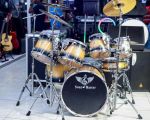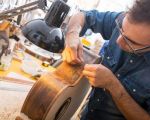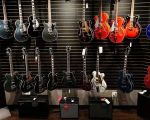How to Organize Your Music Production Workspace
As a musician and music producer, I've spent countless hours in my studio, working on everything from sound design to final mixes. Over the years, I’ve learned that having a well-organized workspace can significantly improve your workflow, creativity, and overall productivity. A cluttered or disorganized music production space can lead to frustration, delays, and even a lack of inspiration. That’s why I decided to share my tips on how to organize your music production workspace to help you get the most out of your creative process.
1. Start with the Basics: Clear Your Space
When organizing any workspace, the first step is always to clear the area. In my case, this meant removing unnecessary equipment, cables, and random items that had accumulated over time. You’ll be surprised how much better you can think when you’re not overwhelmed by clutter. I recommend starting fresh by clearing your desk, shelves, and floor. Then, take a hard look at everything you need and everything you don’t. If you haven’t used something in the past six months, it might be time to consider donating or selling it.
Once your workspace is clear, think about the items that are essential for your production work. For me, this includes my computer, MIDI keyboard, audio interface, speakers, and other gear that I use on a regular basis. Having only the essential equipment within reach helps me stay focused and efficient during my sessions.
2. Optimize Your Desk Setup
Your desk is the heart of your music production space, so it’s important to get this part right. Over the years, I’ve experimented with different desk configurations to find what works best for me. What I’ve found is that the desk should be spacious enough to accommodate all your primary gear, like your computer, audio interface, keyboard, and speakers. But it shouldn’t be so cluttered that it feels cramped or uncomfortable.
One of the best decisions I made was investing in an ergonomic desk chair. Spending long hours producing music means you’re sitting for extended periods, so comfort is key. I also highly recommend using a desk with built-in cable management options. Nothing kills the vibe more than a tangle of wires, so having a way to hide and organize cables is a huge improvement.
3. Organize Your Cables Effectively
Cables are perhaps the biggest pain point in any music production workspace. I used to be guilty of letting cables get tangled or sprawled all over the floor, but I quickly realized that it was not only distracting, but it also created a safety hazard. The solution? Cable management.
There are many ways to keep cables organized. I use cable clips to keep my power cables in place, and I’ve invested in a few cable organizers to bundle and store the cables that I don’t use frequently. For my studio monitors, I use speaker cable clips to keep everything tidy. Additionally, you can label cables to make it easier to know which is which when you’re in the middle of a project.
4. Create a Designated Area for Each Piece of Equipment
When I first started setting up my studio, I often found myself scrambling to find the tools I needed in the middle of a session. But over time, I learned that having a designated spot for each piece of equipment made a big difference. When everything has its place, you’ll spend less time searching for things and more time being creative.
For example, I keep my headphones, microphone, and interface all in specific drawers or stands so that I can grab them as needed. I also use a few small shelves or racks to store things like sound libraries, external drives, and even cables that I don’t need on the desk itself. This organizational method reduces clutter and ensures that I always know where everything is when I need it.
5. Streamline Your Software and Digital Files
Having a clean and organized workspace isn’t just about physical items—it’s also about your digital environment. As a music producer, I deal with tons of digital files, plugins, and samples. Over time, this can become a massive headache if you don’t have a system for managing it all.
I suggest setting up a folder system on your computer to organize your samples, projects, and presets. For example, create a folder for each genre or type of sound you frequently work with. I also recommend using a cloud storage system to back up important files, so you don’t risk losing any of your work. And make sure to label everything clearly and consistently so that you can find your files easily when you need them.
6. Focus on Lighting and Ambience
The right lighting can transform your studio space and improve your focus. I learned this lesson the hard way when I used to work in dimly lit spaces, often straining my eyes during long production sessions. These days, I use a combination of ambient lighting and focused task lighting. A soft desk lamp helps set the mood, while overhead lights illuminate the entire room for better visibility.
Another tip is to use natural light whenever possible. I’ve found that sunlight can help boost my creativity and energy levels. If your studio doesn’t get much natural light, consider adding LED lights with adjustable brightness to create the right atmosphere for your work.
7. Personalize Your Space
While organization is key, I also believe it’s important to make your music production workspace feel personal. Over the years, I’ve added a few personal touches to my studio, such as plants, artwork, and inspirational quotes. These things might seem small, but they make a huge difference in creating an environment that inspires me and helps me stay motivated.
Adding a bit of personality to your workspace can go a long way in boosting your mood and encouraging productivity. Find things that make you feel good and bring them into your space. Whether it’s a favorite piece of art, a cozy rug, or even some ambient music in the background, making the space your own is key to a comfortable and productive atmosphere.
By following these steps and making a conscious effort to keep my workspace organized, I’ve found that I’m able to work more efficiently and creatively. It may take some time and effort to get things just right, but trust me, it’s worth it. If you’re serious about your music production, taking the time to set up an organized and functional workspace will pay off in the long run. Happy producing!
SEO Title: How to Organize Your Music Production Workspace for Maximum Creativity and Efficiency SEO Keywords: music production workspace, organizing music studio, studio setup tips, music producer workspace, music production organization, music workspace tips SEO Description: Learn how to organize your music production workspace for greater efficiency and creativity. Discover essential tips for setting up your studio space, managing cables, and streamlining your digital files.







